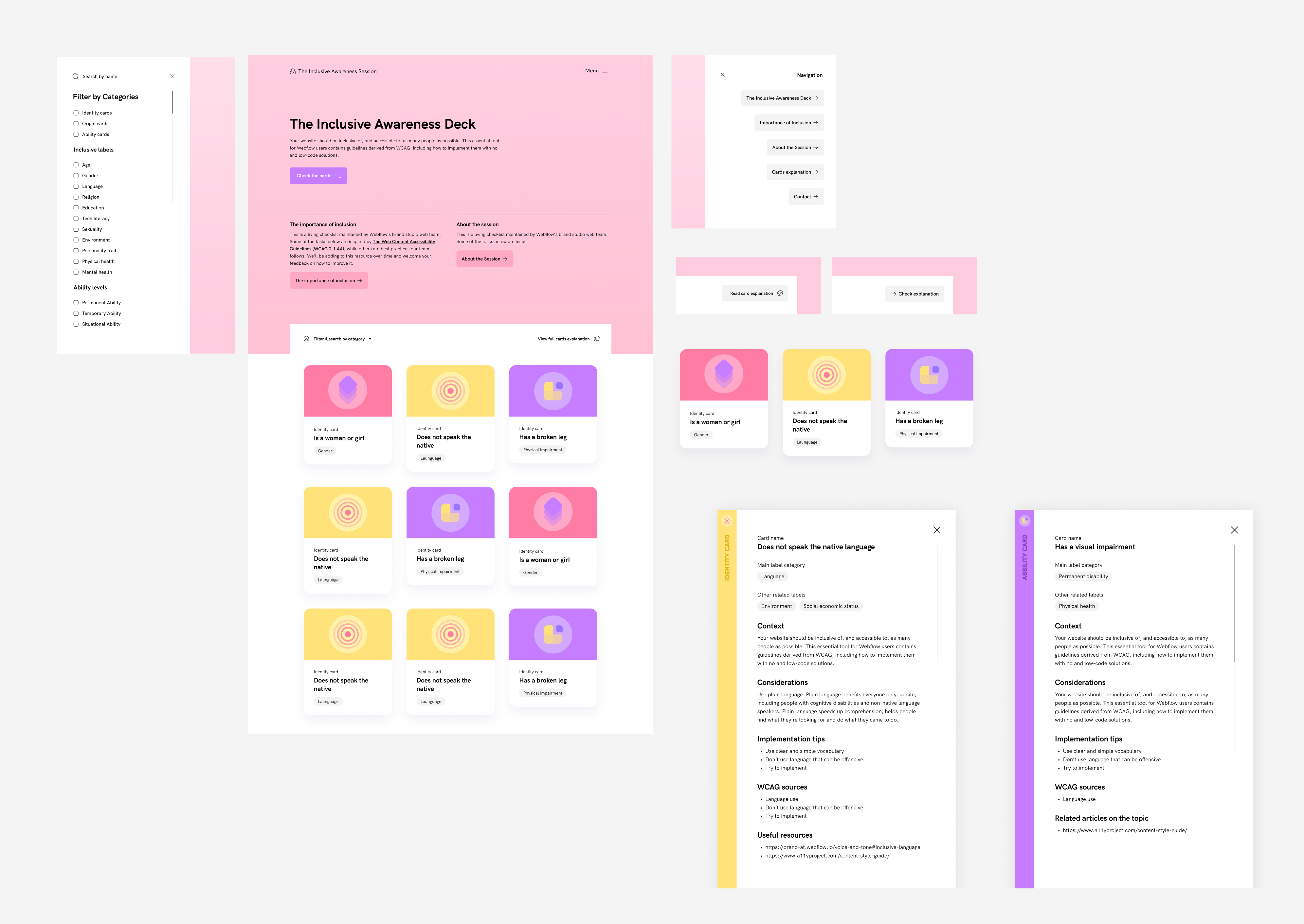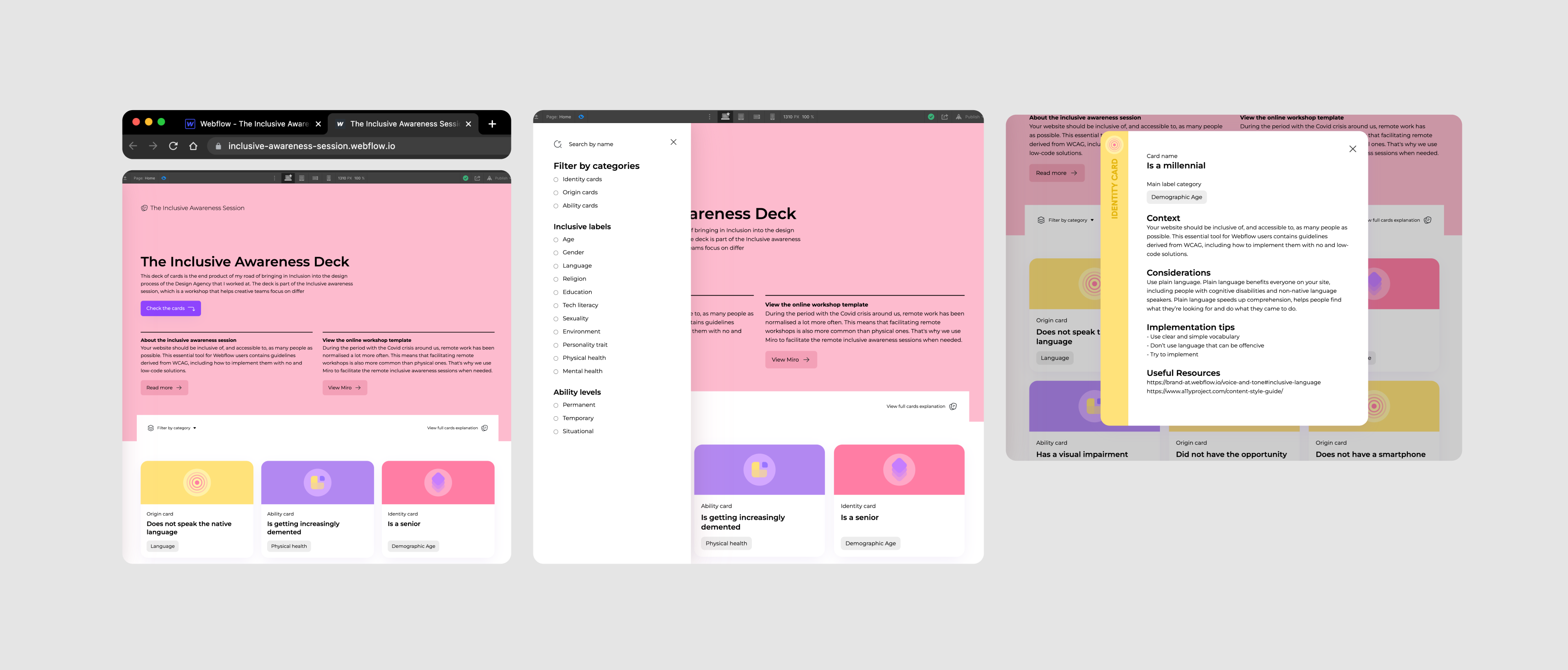Concept creation
Visual Design
"Diving into the world of inclusive design and how we can help other designers uncover their own biases so they can improve their inclusive awareness."
During my studies I had the opportunity to dive into a relevant topic for designers and educate fellow design students using the discovered insights from primary research and testing with prototypes.
I dove into the topic of Inclusive design and found that it covered a very large area. Next to that is it very hard to create actionable steps for the topic because it is partially about a way of thinking or a mindset. During the research, I found out that a large part of an inclusive mindset is about being aware of your own biases. I wanted to discover in what ways I could help designers improve their self-awareness on how inclusive their way of thinking is and where biases may lay.
I formulated the following research question to explore and discover the answer.
"How can we as Communication & Multimedia designers create awareness on designing more inclusively by helping other designers identify their own biases."
Choose a relevant topic within the design industry, formulate a research question, do research and gather insights, create and test a prototype and present the results to fellow design students.

💡 The Problem Statement
The world is currently changing and in movement. It involves that the way that we as society shift towards a more post materialistic viewpoint. Post-materialism represents the change in cultural ideals towards non-material values like self-expression, quality of life, and environmental sustainability. This means that the value our identities is becoming more important. This change gave rise to multiple movements in society like MeToo and Black Lives Matter. Because of these movements the recognition of the relevance and importance of an inclusive society became more apparent. Gradually industries also started to notice the need and importance of these inclusive values, so they are also improving and implementing a more inclusive way of working. Designers also fill in an important role in the rate in which minorities get included or excluded.
Designers generally create ideas based upon their own knowledge and experiences they've accumulated over the years. Not carrying any form of unconscious bias is impossible as we're only human. But by being aware of some of these biases and actively try to use a more inclusive design practice, could eventually help create products that don't unintentionally exclude minority groups. As we, communication and multimedia designers, aim to effectively convey a message or tell a story to a target audience and with as goal so we can improve the lives of humans.
💡 Research Methods and Approach
The methods used for this project:
• Literature study
• Expert interview
• Concept ideation
• Prototyping
• Focus group
• User testing
I started using Literature study / Deskresearch for the basis and foundation for answering most of the straightforward questions. The intention is to provide a deeper understanding of the topics so that I can ask better follow up questions in the follow-up research methods. Upon finding the general information on the topics I will follow-up with an Expert interview. My goal with the expert interview is to speak with someone knowledgeable on the topic of inclusive design.This is so I can learn more about the value of the implementation of it and how I could best raise awareness among designers. The intention is also to find inspiration and discover a direction for creating an usable prototype. When I discover a direction to go into I could start with Ideation and generate different ideas and concepts that I could use or further develop into a usable prototype. To help the ideation phase of the prototype development,I will use an Inspirational wall, which I will be using to gather visual material on which I could base my concept designs and prototype. Finally, using the insight from the research and the interview I will be developing a prototype. This prototype will test if my hypothesis will be true and fill in parts of the answers for the sub-questions. During this process I wil be making use of a Focus group. With the intention of gathering a small group of working designers, ask their perspectives on the topic of inclusion. and test the prototype. During this session the CMD method Participant observation will be focussed on, meaning I will make sure that everybody in the group will actively use the prototype while I try to not interfere or guide them to a desired goal all so that I can have a non biased result. After this focus group I will be using the results to improve the prototype and answer part of the sub-questions. The following method will be the User test. This will be more in depth and more focussed on the participants using the prototype. With this final prototype I can uncover answers on the sub-questions so that I can answer the main research question and follow-up with a recommendation and follow-up question.
"How can we as Communication & Multimedia designers create awareness on
designing more inclusively by helping other designers identify their own biases."
Inclusive design is a methodology that is about including and learning from humans with a diverse range of perspectives. A lot depends on the approach and the right mentality. It is important to actively include different viewpoints to the process and uncover hidden biases.
Focussing on the improvement of awareness on our own biases is a good way to uncover potential points of exclusion. This is because biases can influence how we interpret information, make decisions, and interact with others. It is important for us designers to be aware of their own biases, because they can influence the design process and the rate in which our final products include or exclude groups of people. When trying to educate other designers on the topic of inclusion we need to take into account that not everybody has the same level of excitement to learn. So we want to focus on increasing motivation and lowering the difficulty of the activity.
For my prototype I tested on increasing engagement and interest by utilising gamification on the topic and lowering difficulty by keeping the activity simple. Based on the results of the user tests with my prototype, I can conclude that starting a conversation, sharing perspectives, and empathising with uncommon user scenarios is a very good way to uncover personal biases.
My final recommendation would be to actively surround ourself with the topic. You can follow inclusive design principles, as they help enforce an inclusive mentality. You can actively expose yourself to the topic of inclusion. Start a dialogue on the topic with colleagues or friends. with which you can share experiences and insights. Or use inclusive toolboxes or games to make the learning interesting, engaging and or fun. Following any of these recommendations will certainly increase your inclusive design knowledge and awareness.
What is inclusive design and why is it important?
Inclusive design is a design methodology that enables and draws on the full range of human diversity. This involves the designing of products, services, and environments with a goal to be usable by as many people as possible regardless of their abilities, disabilities, age, gender, race, ethnicity, culture, sexual orientation, or any other individual characteristic. Inclusive design is about including and learning from people with a diverse range of perspectives. Designing inclusively doesn't mean you're making one thing for al people. You're designing a diversity of ways for everyone to participate in an experience. Every choice w e make has an effect since it has the potential to either raise or lower barriers to participation in society. When aiming for a more inclusive society we should take responsibility by lowering these barriers through the creation of inclusive products, services. and experiences. Around 15% of the world's population experiences some form of disability. Designing more inclusively ensures that everyone, regardless of their abilities, can use and benefit from a product or service.
By considering the needs of diverse users, inclusive design can create solutions that are more accessible, efficient, and equitable for all. That's why it's important to understand why and how people are getting excluded. Understanding this gives us actionable steps to take towards more inclusive design solutions.
How can designers implement inclusive design practices?
Inclusive design is hard to fully grasp without gathering information. Still there are multiple ways to start implementing it. Because Inclusive design is about the process and is oriented a lot on the mentality, a good way to implement Inclusive design is to follow inclusive design principles. The principles help designers develop experiences that can be used by a diverse group of users. A designer should take on an inclusive design mindset from the beginning. This wil increase the success of it meeting the accessibility standards at the end. The principles are not absolute but guidelines that can vary depending on situations, but the general principles that designers can focus on are:
1. Identify ability-based exclusion
2. Identify situational challenges
3. Avoid personal biases
4. Offer various ways to engage
5. Provide equivalent experiences to all users
Next to design principles you can actively improve your awareness on designing more inclusively by using these methods.
1. Keep exposing yourself to the topic of inclusion
2. Seek out diverse perspectives
3. Practice empathy
4. Reflect on your design process
What are biases and why is it important for designers to be aware of their own biases?
Biases are a natural part of who we are as humans. Our biases exist out of unintentional views, subconscious views or prejudices that affect how we see. feel about, and act against specific social groups or circumstances.They can influence how we interpret information, make decisions, and interact with others.It is important for us designers to be aware of their own biases because they can influence the design process and the resulting solutions. If you're not careful, your bias could lead to designs that exclude or discriminate against certain groups of people.
What is an inclusive mentality and how can you develop one?
What is an inclusive mentality and how can you develop one? Making sure that various viewpoints are actively heard, understood, and applied is the goal of this inclusive mentality. Also important is the fact that decisions are made in collaboration and with multiple perspectives which influence the decision-making. You can increase or grow your inclusive mentality through a combination of education, self-awareness and actively engage with a topic and conversations.
How do you motivate other designers to start learning a new topic?
The likeness for a designer to start learning new topics depends on the willingness he has to do the behaviour and the difficulty in completing the behaviour. So we want to focus on increasing motivation and lowering difficulty. Jonas Berger shared that another strong "catalyst" to change is lowering barriers of existing obstacles. So that could mean focussing on making ti easy to learn is the best course of action. Examples low difficulty but fun or engaging strategies are:
• Facilitating workshops with experts or make use of gamification to stimulate the willingness to learn.
How do you create an engaging way of improving knowledge on inclusive design?
How do you create an engaging way of improving knowledge on inclusive design? There are multiple ways to facilitate engagement in the education of inclusion. One frequently used by companies si the facilitation of workshops that get involved with the theme inclusion. This is about actively sharing knowledge and guiding participants to other views. You can invite experts to talk or focus on starting the dialogue on inclusive awareness. But another way that I personally prefer is the active use of gamification to discover our perceptions about Inclusion and our own biases. This is done with a group or team and try to start a dialogue which facilitates the sharing of perspectives. Using my own prototype I discover that having a group actively empathise with exclusion or inclusion is a really good way to surface viewpoints and makes them sharable to talk about.
The concept I developed is the Cards for Inclusive Bias. It focuses on using gamification to involve people to the topic of inclusive thinking. By using cards you can build different personas that have specific category traits that are related to inclusive markers. With this card game you build user scenarios that have let you empathise with their perspective as you build upon an increasingly difficult unique scenario. Based on the research I created 3 principles for the development of the concept and following prototypes.
1. Must be lightly digestible
2. Focus on empathy to see other perspectives.
3. Make the topic easy to discuss
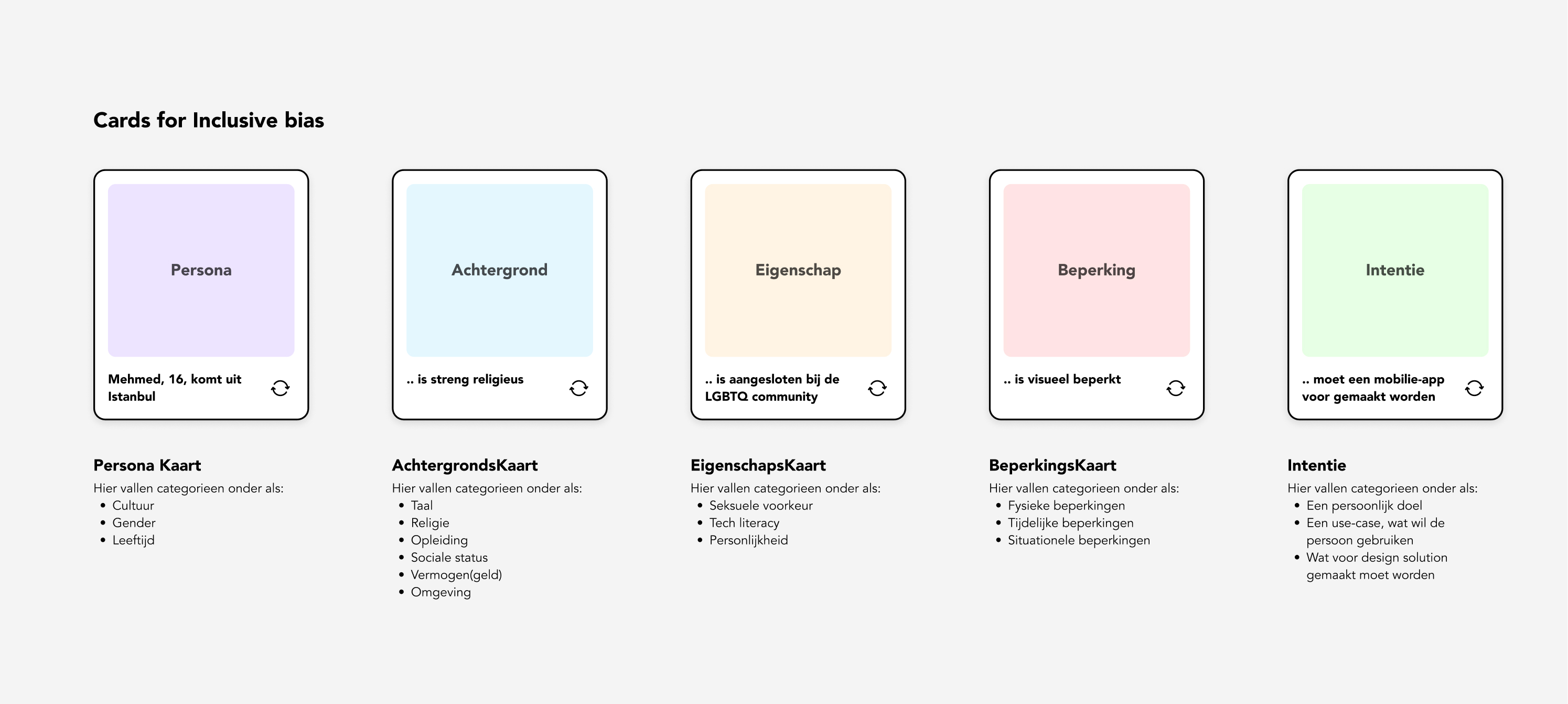
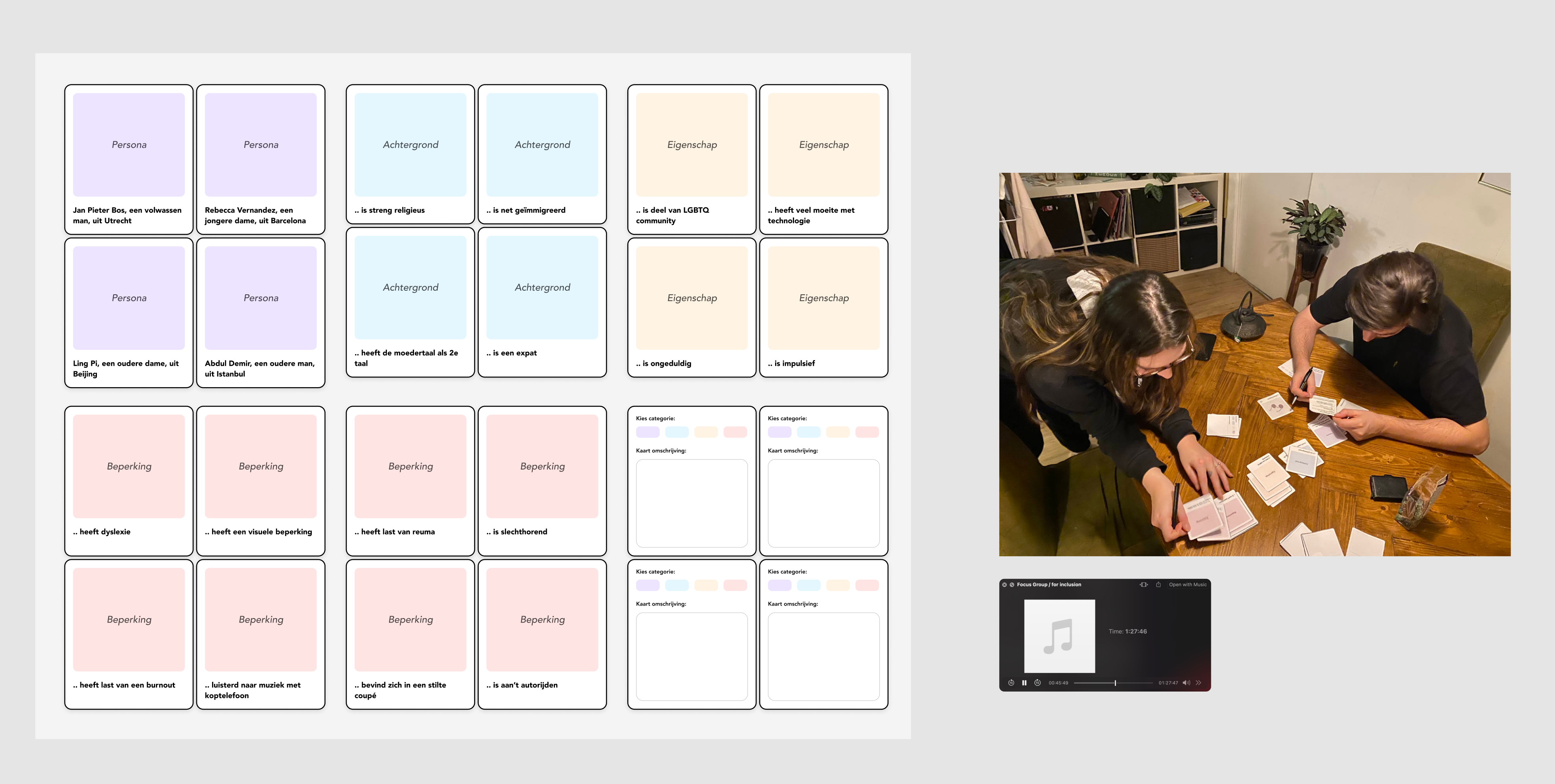
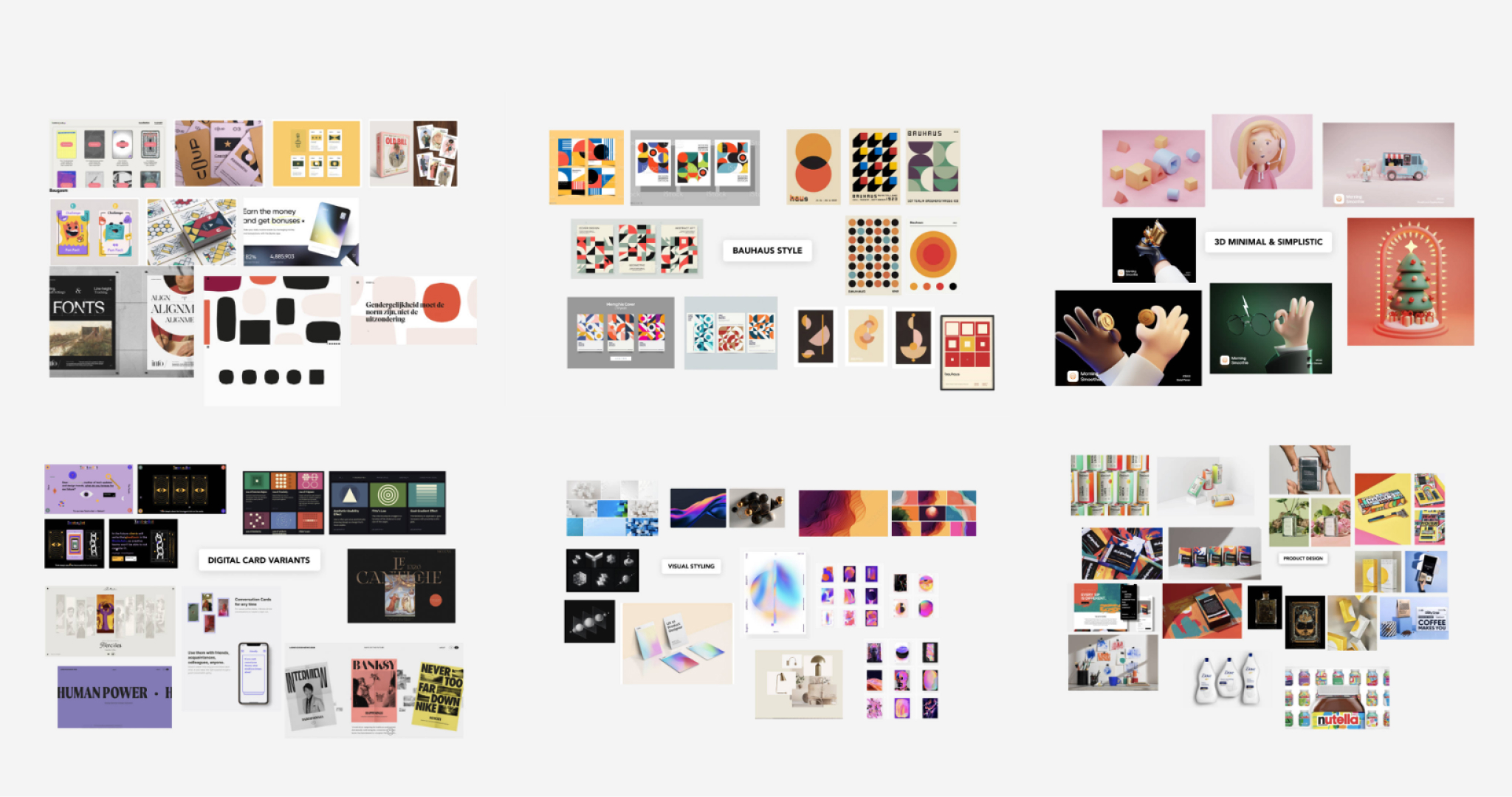
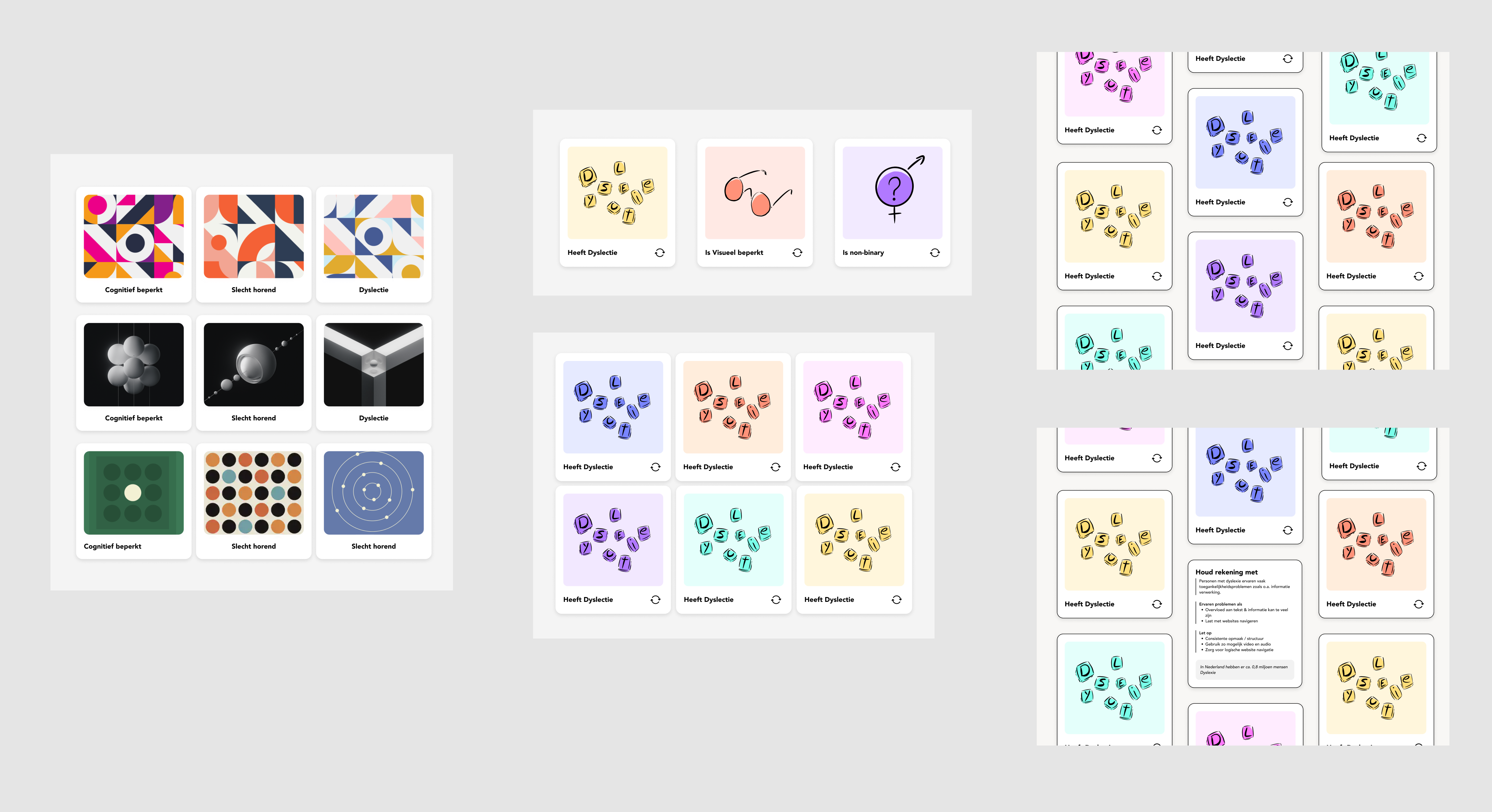


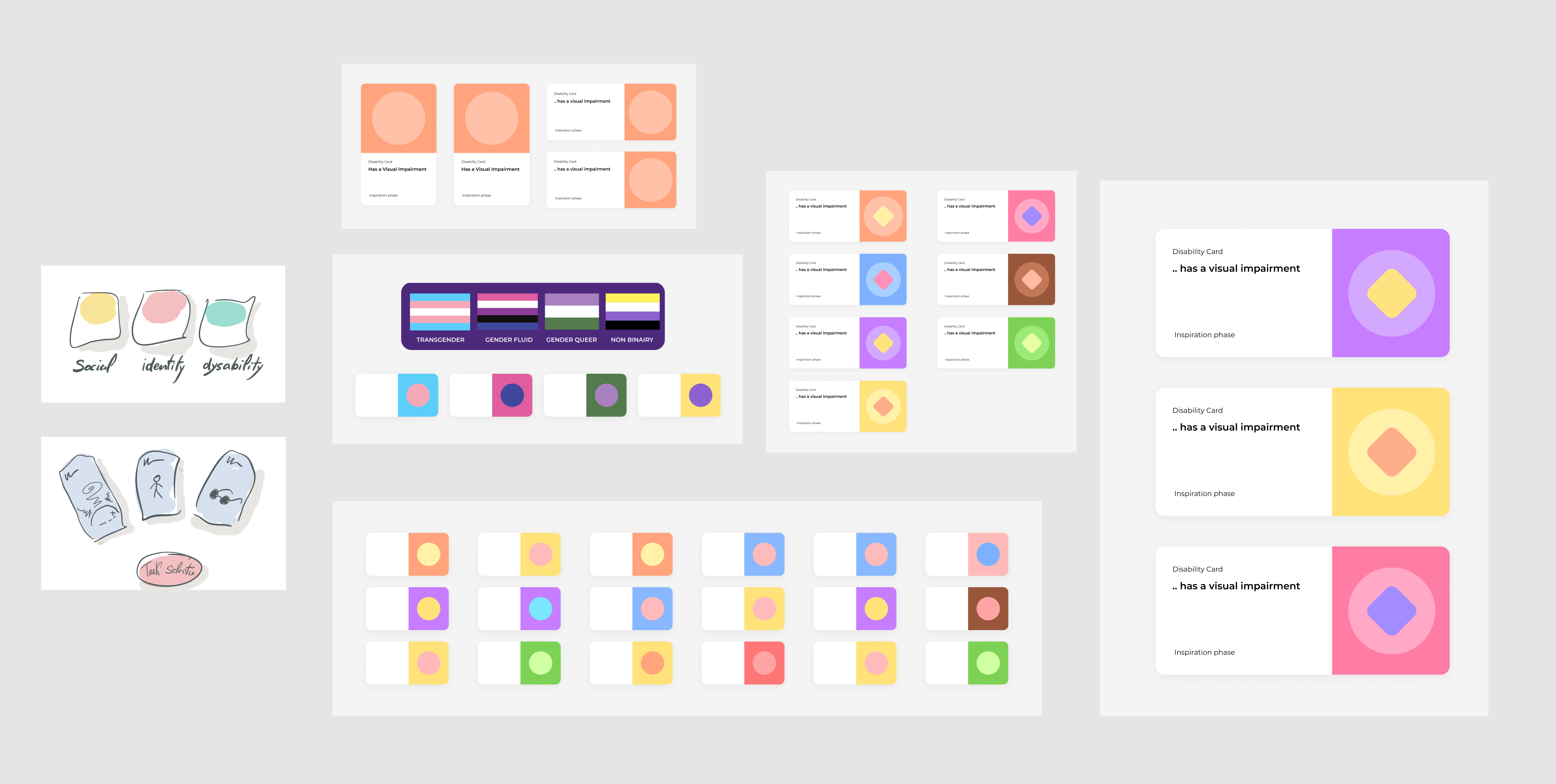
To find out if my final prototype works, I organised an User test. With this I wanted to facilitate an Inclusive Awareness Session with the new Cards. To validate whether this prototype achieves its goal more efficiently than the previous prototype. I invited old and and still studying CMD'ers to do this User test.
The focus of the Final User Test was to find out if the four main goals were achieved:
• Make the participants actively empathise with unconventional user scenarios.
• Make them search for points where exclusion can occur and what problems relate to that.
• Let them think of solutions to these problems.
• Let them get insight into their own personal biases.




The reactions and insights of the user tests unfolded in a really positive way and the inclusive awareness session was a succes. The final key-insights I retrieved from the session were:
•At the start everybody had to get into a flow. But after a few minutes everyone participated actively and enthusiastically.
•Allowing humorous remarks on more heavily loaded topics can add to the highlighting of biases or exclusion points.
•Everyone became very aware of the fact that they had some unconscious biases with some of the scenarios. Which made them increase their active empathy in later rounds.
• Linking specific goals to a scenario helps to make the session extra relevant for designers. This ensures that the dialogue is more focused on the development process of design and development, instead of only the general theme of inclusion.
Looking back at the topic, the process and the final results, I can say that I'm happy the way it has unfolded. The results were all according to or surpassing the expectations of success. I learned a lot on the creation of a workshop/session with gamification elements and of course about inclusive design.
After the study project ended I resumed exploration of the project and developed a digitalised prototype version for a online library. I focussed mainly on the visual design & front-end development explorations, but unfortunately did not fill in all te content, Perhaps I will in the future ;)
